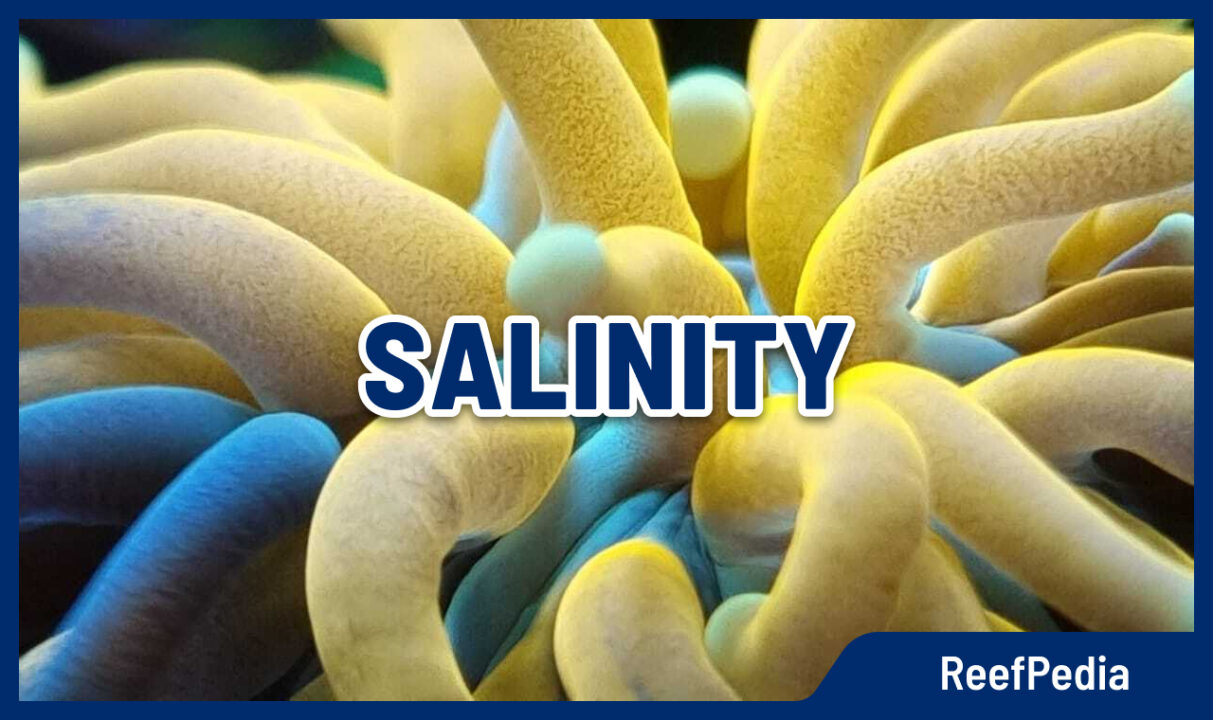Table of Contents
What is salinity?
Salinity is one of the most important parameters in water chemistry in marine aquaristics. A well-run reef tank requires maintaining a constant level of this parameter. The optimal salinity level is 33-35 ppt. In the simplest terms, salinity is defined as the total salt content in grams found in 1 liter of water.
However, in the case of seawater, a more precise definition of salinity must be given:
Salinity is defined by the solids content in grams [g] per 1kg of seawater, after removing all organic matter* and replacing all:
- bromides;Br–(1) and iodides;I– (2) with chlorides;Cl–(i.e. KBr was converted to KCl (1), KI was converted to KCl (2))
- carbonates;CO32-with oxides;O2-(3) (i.e. CaCO3 converted to CaO(3))
It’s important to keep in mind that the salinity of seawater is not just the amount of dissolved sodium chloride (NaCl) in the water, because seawater also includes other salts such as magnesium chloride (MgCl2), sulfates – magnesium sulfate (MgSO4), calcium sulfate (CaSO4), potassium sulfate (K2SO4), and in much smaller amounts calcium carbonate (CaCO3), magnesium bromide (MgBr2) and trace compounds of strontium, boron, fluorine and many other elements.
In the natural environment, there is a difference in the salinity of the seas and oceans. The more red the color of water, the higher salinity we have. The minimum values are 32‰, while the maximum values reach 38‰, with the average salinity of the waters being 35‰. Deviations from the average salinity value are due to various reasons: precipitation, evaporation or ocean currents.


Seawater salinity – surface levels (‰)**
How does salinity affect marine organisms?
Most marine organisms can tolerate salinity in the range of 30-38 ppt, assuming there are no sudden spikes in its value. However, maintaining salinity at 33-35 ppt provides optimal conditions for the growth of animals in the aquarium.

Best salinity range
Sometimes salinity is deliberately manipulated to increase the amount of dissolved oxygen in the water or to make fish less susceptible to infection.
Both high and low salinity cause stress in animals. As a result of stress, one may notice impaired growth in corals, loss of color and lack of polyps. Fish species have been known to die from kidney failure if salinity is kept too low for an extended period of time.
To ensure good conditions for the development of animals in the marine aquarium, the salinity level should definitely be controlled. It can change, among other things, as a result of salt uptake by devices such as a skimmer, or when replenishing evaporated water with RO/DI water.
Salinity determines the density of seawater, which indirectly determines the concentration of all substances contained in it. The more saline the water, the higher its specific gravity.
Salinity units
Salinity can be expressed in different units, depending on the choice of measurement method. Most commonly, salinity is expressed as follows:
- c.w. – specific gravity
- ppt – thousandth part
- PSU – practical unit of salinity
- mS/cm – unit of conductivity
- [‰] – one thousandth of a certain numerical value, called base
For example, when the unit of salinity is ppt and it is 33 ppt, it means nothing more than that there are 33 grams of salt dissolved in 1 liter of water.
1 ppt = 1000 ppm = 1000 mg/L = 0.1 %
Salinity measurement methods
Salinity measurements in marine aquaristics make it possible to respond to changes in the concentration of salts in the water, which are caused, among other things, by water evaporation or the use of devices that capture salts from the circulation. Measuring salinity can be done in several ways, while keeping in mind that the result is affected by temperature. Therefore, salinity measurements should be made each time at the same temperature or using devices with built-in temperature compensation.
Most often, water salinity measurements are taken at the time of: setting up a new aquarium, preparing brine, and simply for inspection of an existing tank.
In the saltwater aquarium hobby most commonly used devices are
- Aerometer (salinometer) – This is a simple instrument for measuring salinity. It works on the general principle that as the salt content of water increases, so does its density.
- Hand-held refractometer – the most commonly used device by aquarists for measuring salinity. It is an optical device that uses the refractive index to determine the amount of salt in the water.
- Digital refractometers or salinity meters – allow you to easily and quickly get a salinity result while using temperature compensation.
- Conductivity meter – a device based on measuring the electrical conductivity of water.
- There’s also the empirical formula for determining the salinity (S) of seawater:
S = 1.80655 x [Cl–]
[Cl–] – chlorine ion content in per mille [‰]
* Organic compounds are chemical compounds containing carbon atoms in their structure.
** graphics source
About author

Magdalena Metzler
Privately, I am a mother and a lover of nature and sport. My main interest is quantum chemistry, which hides a whole lot of unsolved mysteries and connections, which is extremely exciting from a scientific point of view.
In my scientific career, I have conducted international projects focused on innovative solutions for many branches of business, e.g. automotive, construction, and now, of course, marine aquaristics.
Working at Reef Factory gave me a passion for marine aquaristics, which I can develop every day, building a chemistry department and creating products that will help aquarists take care of tanks and ensure the highest safety of animals. One of the most exciting memories of working at Reef Factory is the commissioning of the ICP-OES spectrometer, which analyzes the elemental composition of seawater. The method of analysis in ICP is based on an analytical technique, which is a combination of my passion for quantum chemistry and marine aquaristics.
I hope you find my articles on ReefPedia interesting and helpful! Happy reading :))

